
THIAGO MOTTA: THE VALUE OF THE BALL
Motta was born in Brazil, raised by Catalans (he is a graduate of Barcelona’s La Masia academy) and adopted by the Italians, even wearing the No 10 shirt as he won 30 Italy caps.

During his illustrious playing career which spanned across two decades, Thiago has been fortunate enough to have played under a group of managers who would be considered by your average footballing fan as ‘greats’. This paired with his commanding style of play, a metronome, who was a director on the pitch, it was never in doubt that Motta would one day become a coach.
I wanted to take a deep dive into the coach who has transformed Bologna into one of Serie A’s most tactically astute teams, with only three games left in Serie A, I Rossoblù are well on course to finish in the top half of Serie A. Motta could well secure Bologna FC with their highest league finish since 2011/12, when they finished in 9th place under Stefano Pioli.
The Value of the Ball
Motta’s thesis when undertaking his coaching badges at the FIGC’s Coverciano Technical Centre was titled ‘The Value of the Ball’.
The relationship with the ball began for me, as it did for almost all children, as an ‘object gift’ from my father when I was a kid.
The thesis walks the reader through the transition from him being a boy, to the managers which have helped to shape his footballing philosophy and significant importance placed on the value of the ball.
With his transfer to Barcelona, all the founding elements were expanded, deepened and perfected, reinforcing the awareness of the centrality of the ball and its management, individually and collectively, as an expression of the football game. In short, the ball and its management became the fulcrum of a personal and collective of more structured interpretation of the game, which in fact also laid the foundations of the winners from the future Barcelona in La Liga and Europe.
Motta’s arrival in Italy allowed him to enrich and consolidate his technical and tactical background, but this time according to a different footballing philosophy. In Italy the focus was moved from the ball to the alternative occupation of space.
I was not until Mott’s spell under Gianpero Gasperini at Genoa, where he gained exposure to a more elaborate management of verticalisation. Not only by means of direct passages between the lines, but favouring an organised structure of passageways. Motta, deployed as a regista, was instructed to not only bypass the build-up phase and play a more direct approach to serving the number 9, but instructed to follow the pass, enabling Motta to be present in the opponents area. The lightbulb moment for Motta was when Gasperini made him notice that he could put the number 9 into a shooting position, but would automatically exclude himself from the action and consequently reduce the creative teamwork alternatives to get the goal.
It was not until Motta secured a move to France, that his final educational and intellectual path surrounding the concept of the game would be complete. At PSG Thiago gained exposure to both Carlo Ancelotti, and Laurent Blanc. Here Motta would adopt the concept surrounding the importance of centrality.
Key components of Thiago Motta’s philosophy.
Thiago Motta’s philosophy is to pack central areas and largely leave the wide channels open to the full-backs. Crowding the centre of the pitch performs two main functions. Firstly, it ensures that there are passing options around the ball player at all times and promotes quick interchanges to break through pressure. Out of possession, it also allows Bologna to counter-press quickly should they lose the ball and win it back quickly.
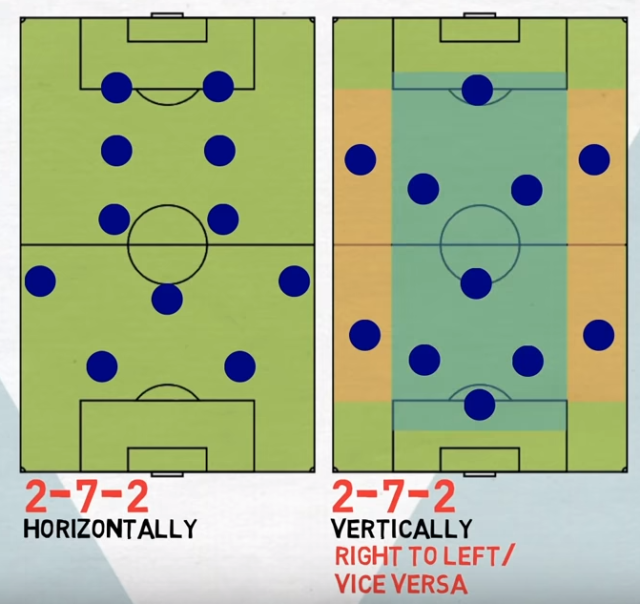
Tifo Football Thiago Motta’s 2-7-2 Formation Explained
It is this central overload which sent the football community into a whirlwind after an interview with Gazzetta dello Sport in 2018, in which Motta described his tactic, the way he saw it from his position on the side-line, the 2-7-2.
“I count the goalkeeper as one of the seven players in the middle of the pitch,” he said. “For me, the striker is the first defender and the goalkeeper the first attacker.”
As with most possession based systems (Total Football), playing from the back is essential, the key ideas is to control possession and methodically work it up the pitch, using numerical superiority. Viewed through the lens of positional play, the goalkeeper being involved in the build up in this way provides a numerical superiority for the team in possession. This creates a decisional crisis for the opposite team, who will have to make a choice between applying pressure on the goalkeeper, leaving an outfield player open to receive a pass, or stay compact and allow the opponent to distribute the ball with relative ease.
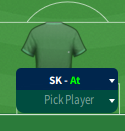
With an Attack duty, the Sweeper Keeper will travel some distance outside his area and be happy to move out with the ball at his feet, certainly high risk, high reward, but something which I feel will really exaggerate the role which the player should play in the build-up phase of play.
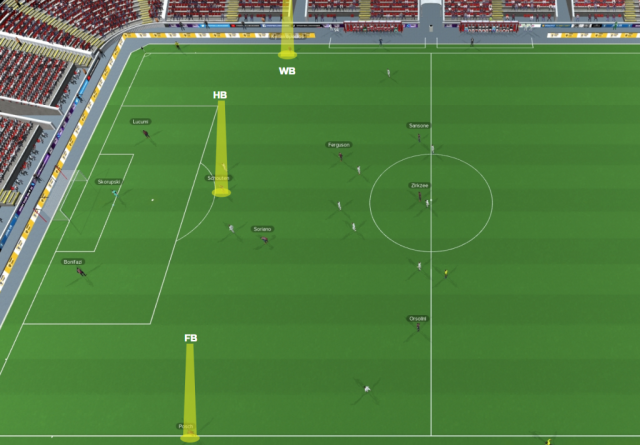
Above is an example of a typical build-up stemming from a goal kick, you will note both centre-back have taken wide positions either side of the keeper, whilst the full-backs have positioned themselves high and wide. What this positioning enables, along with the half-back dropping deep to provide a passing option, is create many diamonds, one around the ball carrier and others across the park, when looking at others positioning.
Motta has also moved away from using a traditional number nine, and instead prefers to use a forward who can drop deep to link play and pull centre-backs away from their defensive unit, but also run the channels and rotate with Barrow and Orsolini.
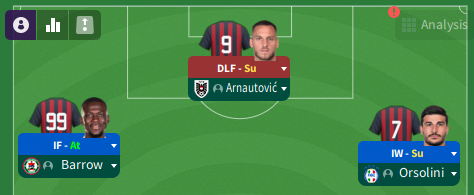
Our subject, Austrian international Marko Arnautović is perfect for this role, as the 33 year-old possesses the following traits;
- Tries Killer Balls Often – Marko is well adept at playing those low percentage passes, he has phenomenal passing ability for a centre forward, passing (15), technique (17), and vision (17).
- Comes Deep To Get The Ball – this trait is pretty self explanatory, influencing the amount of times the player drops behind the line to receive possession in more space.
- Plays With Back To Goal – this trait is all about Marko’s ability to hold the ball up in attacking areas, he has exceptional strength (18) and balance (16), which reflects how well he can stay on his feet under pressure and wait for the supporting players to occupy all five vertical channels.
- Moves Into Channels – increasing the frequency in which he will move into space between their position and a wide attacking position, this paired with the above will keep the opposition on their toes, as he has the ability to influence the creation phase or be a threat in the vacant space behind.
Calcio is not table football. Movement matters. You can be super-attacking in a 3-5-2 and defensive in a 4-3-3.
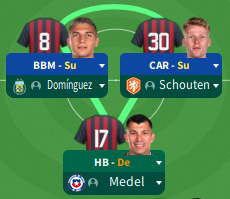
Motta has also made the most of his players individual qualities, notably in midfield, where he has a perfect blend of dynamism, strength, passing and goal instinct that lies at the heart of the teams fluidity.

The above table which I have produced helps to highlight the diversity within the group, with each player a more than reliable passer of the ball. Jerdy Schouten the brains and Gary Medel the brawn, whilst Nicolás Domínguez adds his dynamism, and Lewis Ferguson, the goal threat.
Fluidity in Football Manager
The core of Motta’s football, in which the occupation of spaces is much more important than rigid positions, can easily be implemented in Football Manager. Motta’s side play fluid football, or in FM terms, very fluid/fluid team fluidity.
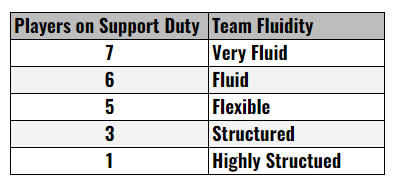
As you can see from the above, team fluidity is linked to player duties, which makes total sense, the more players you have playing a supporting role, the more likely these individuals will share their positional responsibilities, moving up and down the pitch together as a more fluid/compact unit. Whilst with more structured tactics the responsibilities of the players on the pitch are more specific, with defenders, defending, and attackers, attacking.
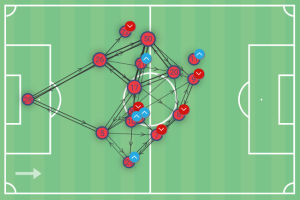
Bologna’s build-up play normally goes out to the wide areas where the team attempt to use combination play to bypass the opponent’s pressure to move forward up the pitch. In order to attempt to force this within the match engine, I have instructed both central defenders to ‘Stay Wider’ which encourages those that play within the spaces in the middle of the pitch and the wide areas to stretch the game over the full width of the playing surface, rather than staying central.
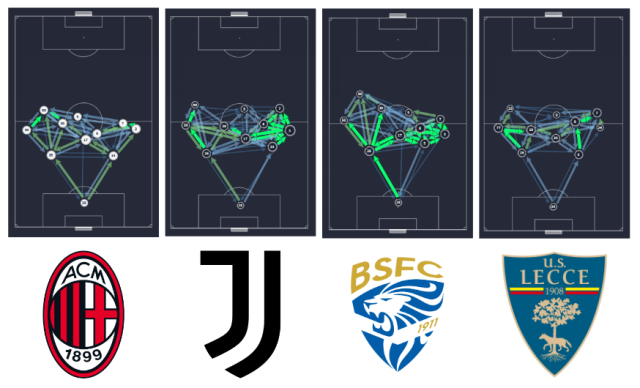
In my humble opinion, the above sample of pass maps above highlight perfectly how heavy the links are down the flanks, aiding our sides progression.
Tactical recreation
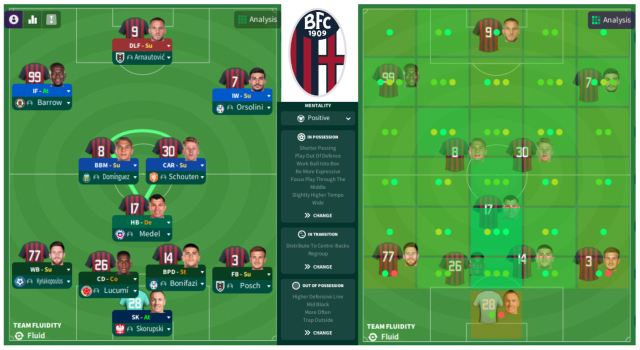
Here is my tactical recreation in all of its beauty, looking at the in game tactical analysis screen, we are informed that we have a high volume of positive relationships across the pitch, especially centrally, where most relationships are labelled as areas of strength or positive signs. It is for this reason that I have selected the ‘Focus Play Through The Middle’ team instruction to add an intense attacking focus in the area in which we are most strongest.
For those of you who wat to know the detail surrounding some of the additional player instructions, along with my reasoning for each choice, please see the below.
Full-Back (Support) – Shoot Less Often, Sit Narrower, Tackle Harder
I want both of our wide players in the defensive block to tackle harder, this instruction enables the player to be more forceful/combative when challenging for possession. We have shown our collective strength centrally, the wide players at the bottom of the pitch are the only segments of the pitch which have a high negative influence, therefore the need to be more aggressive.
I have also instructed the this player to sit more narrow, enabling him to provide an additional body close to the central column, offering another outlet for recycling the ball, the shoot less often instruction speaks for itself.
Ball Playing Defender (Stopper) – Stay wider
Central Defender (Cover) – Stay wider
Wing Back (Support) – Tackle Harder
Half Back – Take Fewer Risks
The fulcrum of the side will need to adopt a patient and sensible passing approach to ensure possession is maintained, playing as a half-back in this system, this player has the most passing lanes available to him and therefore will be our metronome.
Carrilero – Take More Risks
There is a need for at least one of the midfield three to play those low percentage vertical passes, this responsibility has been given to the Carrilero due to this role often playing under the main attacking swarm,
Box to Box Midfielder – Get Further Forward
This trait will ensure we have another player running in behind, the wide playing style will also make bigger spaces between the opposing defensive line for the player to break, getting another body in the box.
Inverted winger (Support) – Cross Less Often
Again, this one is pretty much self explanatory, we don’t want to keep losing possession in the final third, trusting our ability to move players, manipulating space to then exploit.
Whilst this tactic is by no means the final article, and I admit some of the team instructions deviate a little from Thiago Motta’s philosophy, I feel this is a good replication, and one which will show the benefits of adopting a fluid footballing system, I will look to continue the save and provide further tactical/analytical updates as I progress, I hope you have enjoyed the read




donde se puede descargar esta tactica?